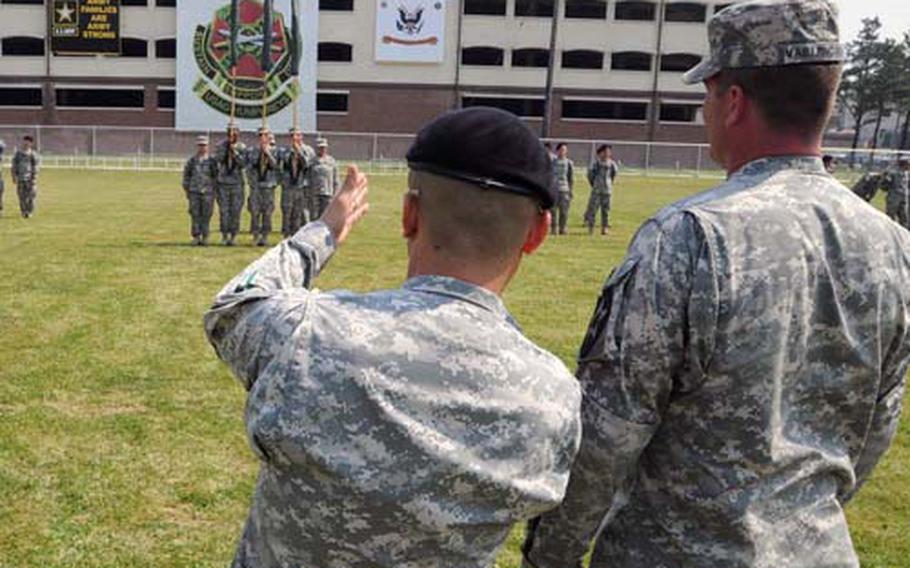
Command Sgt. Maj. Jason K. Kim, center, talks with Sgt. 1st Class Evan Vaillencourt, right, and Master Sgt. Glen Harrison on Freedom Field at Camp Humphreys, South Korea. Troops held a walk-through rehearsal Monday for Wednesday’s change-of-command ceremony at which the U.S. Army Garrison-Humphreys gets a new commander. (Bob McElroy / Courtesy of the U.S. Army)
CAMP HUMPHREYS, South Korea — The parade ground here is reseeded and the grass freshly cut. The troops will be aligned on the field Wednesday morning, the color guard will be in place, each unit standing on spots carefully marked days before the change-of-command ceremony.
And by the time the spectators are seated and the 8th U.S. Army Band sounds “Attention,” there will be no turning back. It’s curtain up, live.
The U.S. Army Garrison-Humphreys will have a new commander. At a ceremony set for 10 a.m. Wednesday at Freedom Field, Col. John E. Dumoulin Jr. is to relinquish command to Col. Joe Moore. Dumoulin moves to a new assignment as executive officer for the U.S. Forces Korea commander in Seoul.
For a ceremony scheduled to last half an hour, a small army of planners has worked for weeks to see that things go off without a hitch.
Change-of-command ceremonies are important for the troops, families and others who make up a garrison because getting a new commander is not unlike getting a new mayor.
But it’s also a milestone for the departing commander and spouse: an important tour of duty is wrapped up; a new stage of life and career is about to begin.
“A change of command is like a wedding,” said garrison spokesman Robert H. McElroy. “It’s a once-in-a-lifetime thing and you want to get it right.
“Because this is a special day for the commanders and the spouses and you don’t want to screw it up,” he said. “You can’t go back and make it over. You’ve got to get it right the first time and preparation is the key.”
That preparation saw dozens of garrison officials holding repeated planning sessions that covered a multitude of tasks. And scores of soldiers took part in rehearsals. Markers had to be put down in precisely the right places so speakers, troops in formation and others taking part would know exactly where to stand.
Work crews cut grass, trimmed hedges, swept streets, set out traffic signs.
There were the 400 invitations that had to be written, printed and mailed out or hand-delivered; a program that had to be designed, with 250 copies printed.
The 80 folding chairs had to be the same size and type. Bleachers had to be set up.
Planners had to decide what areas should be set aside for parking. Military police officers had to be positioned at key intersections to guide motorists to the field.
Planning and teamwork was crucial, and nothing could be left to chance, said Staff Sgt. Linette Keller, lead coordinator for the ceremony.
“Anything can happen between now and then,” she said Monday. “For example, we have a total of four vocalists. We only need two. However, things do happen. Let’s say somebody has a sore throat … you need back-ups for the back-ups.
“That’s what’s meant by ‘Everything’s locked in Jell-O,’ ” she said, quoting a quip she attributed to one of the officers involved in the planning.
“Everything is ‘locked in Jell-O’ until the day of execution,” Keller said. “Once you’re actually out there on the field and it’s time to execute, that’s when everything is locked in and it’s time to go, and you can say, ‘OK, here we go! We’re at execution.’ ”